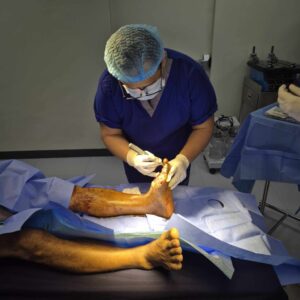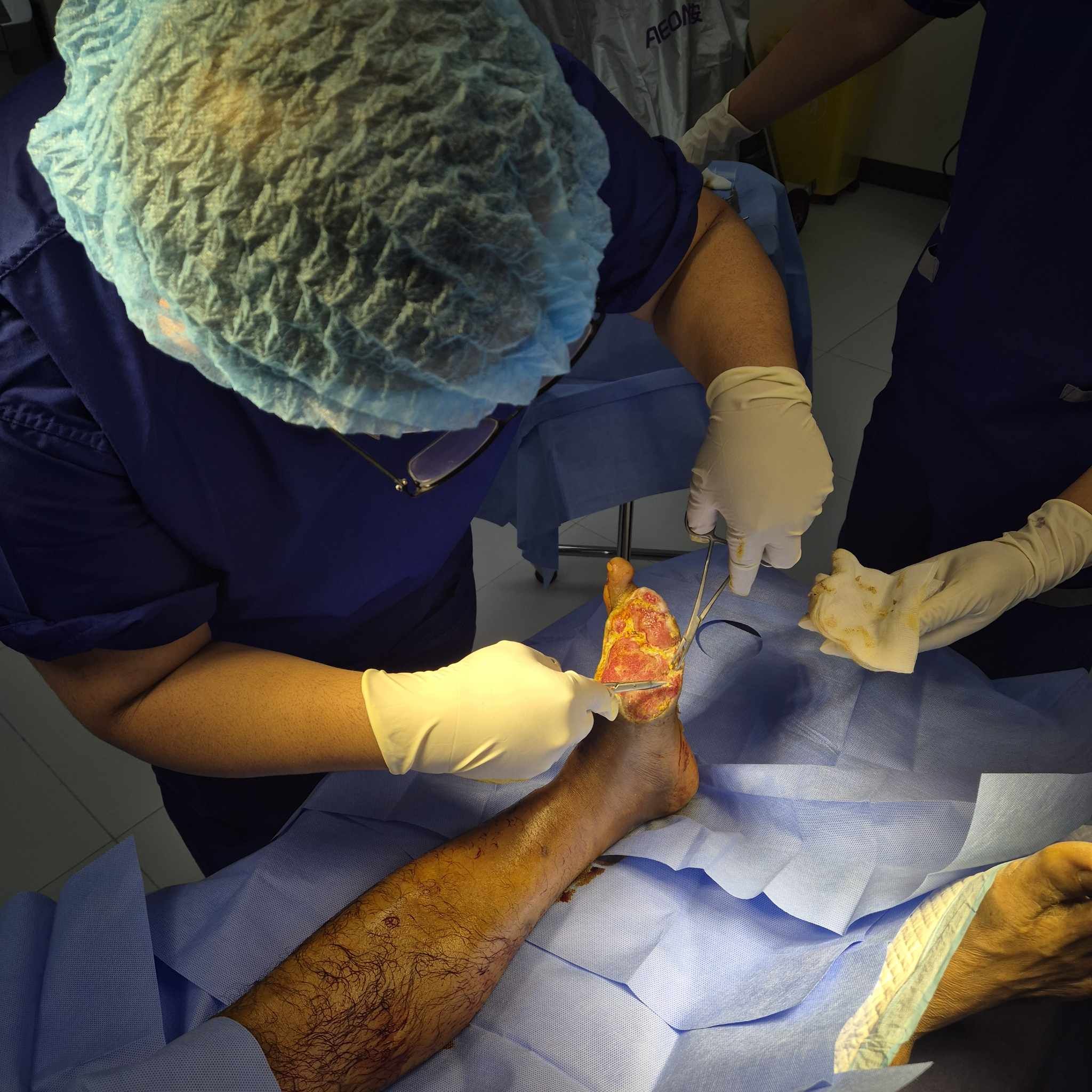Debridement Services refer to the controlled removal of dead, damaged, or infected tissue that prevents a wound from healing properly. When unhealthy tissue stays on a wound, it blocks oxygen flow, traps bacteria, and causes delays in skin regeneration. Debridement Services address these challenges by clearing unwanted tissue so fresh, healthy cells can grow.
Many patients are unaware that untreated necrotic tissue can cause prolonged inflammation, foul-smelling discharge, and infections that may spread. Debridement Services lower risks and create an ideal wound bed that supports fast and stable recovery. These services are especially important for diabetic patients, individuals with low circulation, and those recovering from surgery or traumatic injuries.
Understanding how Debridement Services work helps patients appreciate their role in healing. The process is not simply about cleaning a wound—it is a targeted medical procedure that focuses on restoring proper tissue health and preventing complications that may affect mobility, daily comfort, and quality of life.
Types of Debridement Services Offered in Modern Wound Care
Debridement Services come in several forms, each suited for specific wound types and patient needs. Mechanical debridement uses moist gauze or irrigation to clear surface debris. Enzymatic debridement involves special gels or ointments that break down unhealthy tissue. Autolytic debridement uses the body’s natural moisture and dressing support to soften and dissolve dead tissue over time.
Surgical debridement is often recommended for severe wounds requiring immediate and thorough removal of necrotic tissue. Many advanced clinics now provide ultrasonic Debridement Services, which use soundwave-driven tools to remove dead tissue with precision while protecting healthy skin. This method is known for improving comfort and reducing procedure time.
Each method has its advantages. Skilled clinicians choose the right one based on wound depth, infection level, circulation quality, and overall patient condition. A thorough assessment ensures Debridement Services work effectively and safely, especially for patients with underlying health concerns.
Conditions That Require Debridement Services
Debridement Services are essential for a wide range of wound conditions. Chronic wounds such as diabetic foot ulcers often accumulate thick layers of necrotic tissue that prevent healing. Pressure sores, which develop from prolonged pressure on the skin, frequently require repeated debridement to restore healthy tissue.
Non-healing wounds that show little progress over weeks or months often benefit from Debridement Services because they remove barriers to recovery. Infected wounds containing pus, odor, or dark tissue need prompt attention to prevent the spread of bacteria. Surgical wounds may also develop complications that require additional tissue removal to support closure.
Patients who sustain traumatic injuries, such as deep cuts, burns, or crushed tissue, frequently need Debridement Services to remove damaged skin and allow new tissue to form properly. Any wound that appears stagnant, discolored, or painful for an extended period should be evaluated for possible debridement.
Step-by-Step Process of Debridement Services
Debridement Services begin with a comprehensive wound assessment. Clinicians examine tissue color, depth, moisture, circulation, and signs of infection. They also review the patient’s health history, medications, and lifestyle to ensure the safest approach.
Once the correct method is selected, the wound is cleaned, and the surrounding skin is protected. During the procedure, unhealthy tissue is carefully removed using tools or products suited for the chosen method. Ultrasonic Debridement Services, for example, use soundwave-powered instruments that break down necrotic tissue while minimizing discomfort.
After tissue removal, clinicians apply advanced dressings designed to maintain moisture balance, protect the wound from bacteria, and support tissue growth. Pain control may be included before and after the session, depending on the patient’s sensitivity and wound condition.
Patients receive clear instructions about aftercare, expected sensations, dressing changes, and signs that require immediate attention. Many individuals need recurring Debridement Services until healthy tissue fully replaces damaged areas and healing is stable.
Benefits of Professional Debridement Services
Debridement Services offer several important benefits for patients with chronic or complicated wounds. Removal of necrotic tissue speeds up recovery because healthy skin can grow without obstruction. Cleaning the wound’s surface helps reduce infection risk and removes bacteria-heavy buildup that may cause foul odor or swelling.
Better circulation is another advantage, as Debridement Services often stimulate improved blood flow to the affected area. This supports oxygen delivery and nutrient absorption, which are vital for recovering tissue. The process also allows healthcare providers to observe wound progression more clearly, making each follow-up more effective.
Debridement Services promote smoother closure, especially for wounds that remain open for long periods. By clearing away unhealthy tissue, clinicians help prevent complications that may lead to hospital admission or more invasive procedures. This makes professional care essential for both immediate healing and long-term prevention.
Why Choosing a Skilled Wound Care Facility Matters
Debridement Services require training, experience, and precision. Patients benefit most when they seek care from a facility specializing in advanced wound management. Skilled clinicians understand how to evaluate different wound types and select the safest and most effective debridement method.
Modern wound care facilities offer updated tools, including ultrasonic systems that ensure highly accurate tissue removal. The use of these tools reduces discomfort, limits trauma to surrounding skin, and improves procedure outcomes. Clinics with dedicated wound specialists provide close monitoring, routine assessments, and customized plans that support full healing.
Choosing the right facility for Debridement Services helps patients avoid unnecessary risks, repeated infections, and long-term wound complications. Quality care also ensures improved patient comfort and faster recovery, especially for conditions that require multiple sessions.
What Patients Should Expect After Debridement Services
After receiving Debridement Services, patients usually notice improvements in wound appearance, such as cleaner edges, reduced discoloration, and better moisture balance. Mild soreness or sensitivity may occur, but this typically fades quickly.
Proper aftercare is essential. Clinicians teach patients how to change dressings, keep the wound clean, and avoid contamination. Warning signs, such as increasing pain, unusual drainage, or spreading redness, must be reported immediately.
Diet and hydration play a major role in tissue repair. Protein-rich foods, vitamins, and adequate water intake support wound closure. Some patients may need mobility adjustments, such as using supportive footwear or reducing pressure on the affected area.
Follow-up visits are a standard part of Debridement Services. These appointments allow clinicians to assess progress, replace dressings, and determine if additional debridement is needed.
Who Should Avoid Debridement or Delay Treatment
Although Debridement Services are widely beneficial, certain individuals must undergo further evaluation before proceeding. Patients with extremely poor circulation may require vascular assessment first. Those with specific bleeding disorders or active systemic infections may also need stabilization prior to treatment.
Some wounds may be too dry, too delicate, or too unstable for aggressive methods. In such cases, clinicians may choose gradual approaches until the wound is ready for more direct tissue removal. The decision always depends on medical safety and long-term healing goals.
How Debridement Services Support Patients With Chronic Conditions
Patients living with diabetes, vascular disease, or long-term mobility limitations often struggle with recurrent wounds. Debridement Services prevent complications by removing tissue that feeds bacteria and slows recovery. Diabetic ulcers, in particular, require frequent monitoring because even small wounds can worsen quickly.
Pressure sores also respond well to Debridement Services because tissue breakdown often occurs deeply. Removing dead layers reduces infection risk and prepares the wound for advanced dressings or treatment options. Surgical and trauma-related wounds follow similar patterns, especially when swelling or infection delays closure.
Debridement Services help patients regain comfort, mobility, and independence by ensuring wounds heal properly and efficiently.
Choosing the Right Clinic for Debridement Services
Selecting the right clinic for Debridement Services involves several considerations. Patients should look for facilities with certified wound specialists who consistently manage chronic and complex wounds. Access to modern equipment, including ultrasonic tools, ensures accurate and gentle tissue removal.
Reputation and patient feedback also matter. A strong track record of successful healing outcomes reflects high-quality care. Convenience, appointment availability, and follow-up systems help patients stay consistent throughout the healing journey.
Debridement Services work best when provided by professionals who understand wound behavior, patient needs, and the importance of personalized care.
Frequently Asked Questions (FAQ)
1. What happens during Debridement Services?
A clinician removes dead or infected tissue using tools or methods suitable for the wound’s condition.
2. Do Debridement Services cause discomfort?
Some patients feel mild pressure or soreness, but clinicians provide measures to improve comfort.
3. How long does healing take after Debridement Services?
Healing time varies depending on wound depth, circulation, and overall health.
4. How do I know if my wound needs Debridement Services?
Signs may include slow healing, discoloration, foul odor, or visible dead tissue.
5. Are Debridement Services safe for diabetic patients?
Yes, they are often necessary to prevent infections and long-term complications.
6. How often are Debridement Services needed?
Frequency depends on wound condition and healing progress.
7. What should I do after my appointment?
Follow all aftercare instructions, keep the wound clean, and attend scheduled follow-ups.











